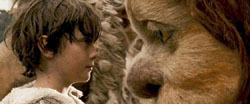My parents bought me plenty of books as a child, and thinking back on it now, a lot of them — "Gerald McBoing Boing," "Harold and the Purple Crayon" or "A Wrinkle In Time" — were pretty strange. (That might explain a few things.) But one book I never got was Maurice Sendak's "Where The Wild Things Are."
For that secret pleasure, I would cross the street to my friend's house, where we'd lie on the floor in his den and flip through its pages. Sendak's shadowy jungle dreamworld of comically grotesque beasts was both disturbing and irresistible, like a nightmare that wasn't scary. (Years later I would recognize that same feeling while watching "Eraserhead.")
Perhaps it was just the Minotaur, but my young mind formed a connection between Sendak's picture book and Pablo Picasso's "Guernica," a print of which hung in my friend's den. I was more right than I knew; they were both expressions of a modern, post-Freudian conception of art, linked to nonrational representations of emotional states.


















With your current subscription plan you can comment on stories. However, before writing your first comment, please create a display name in the Profile section of your subscriber account page.